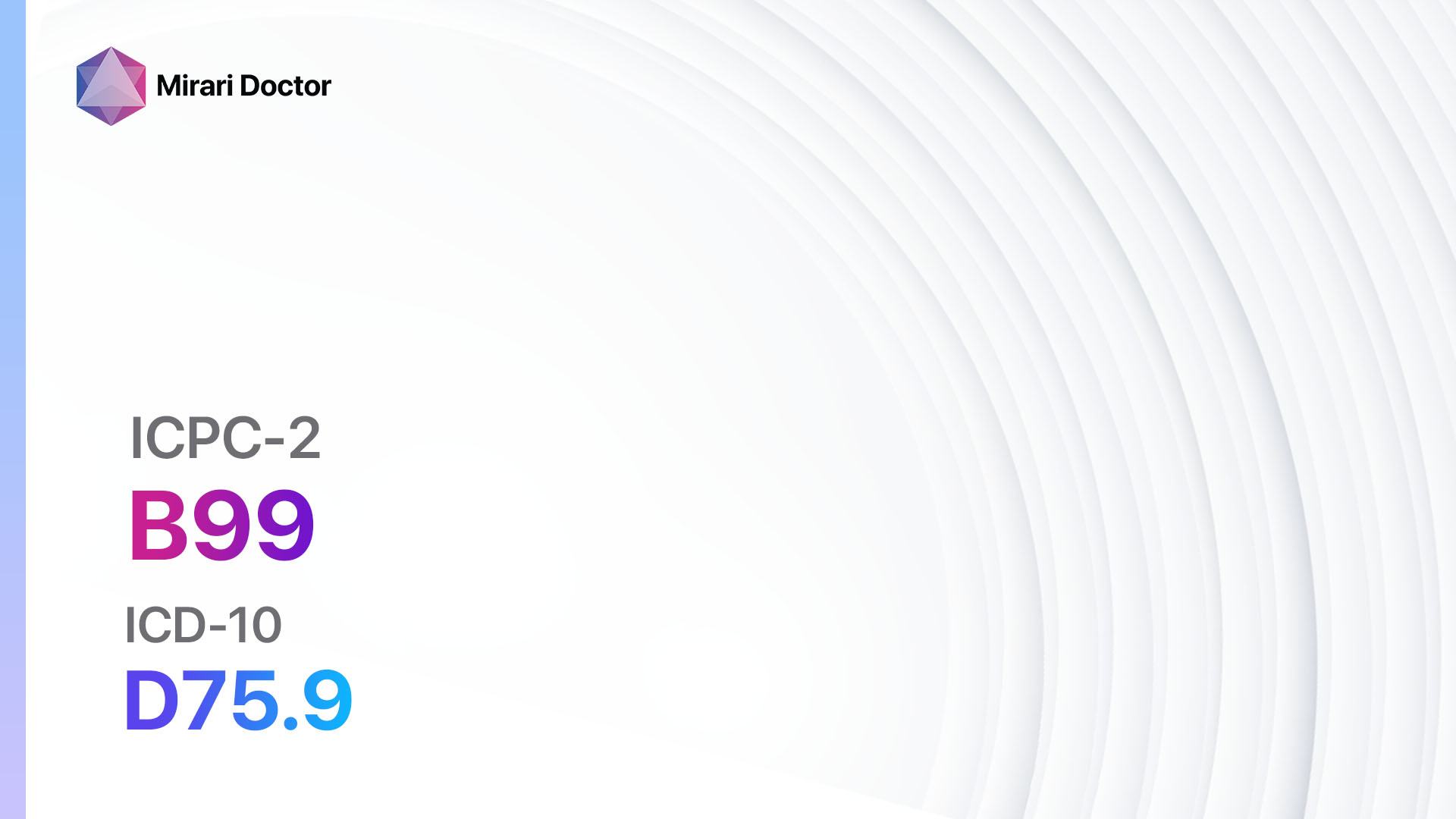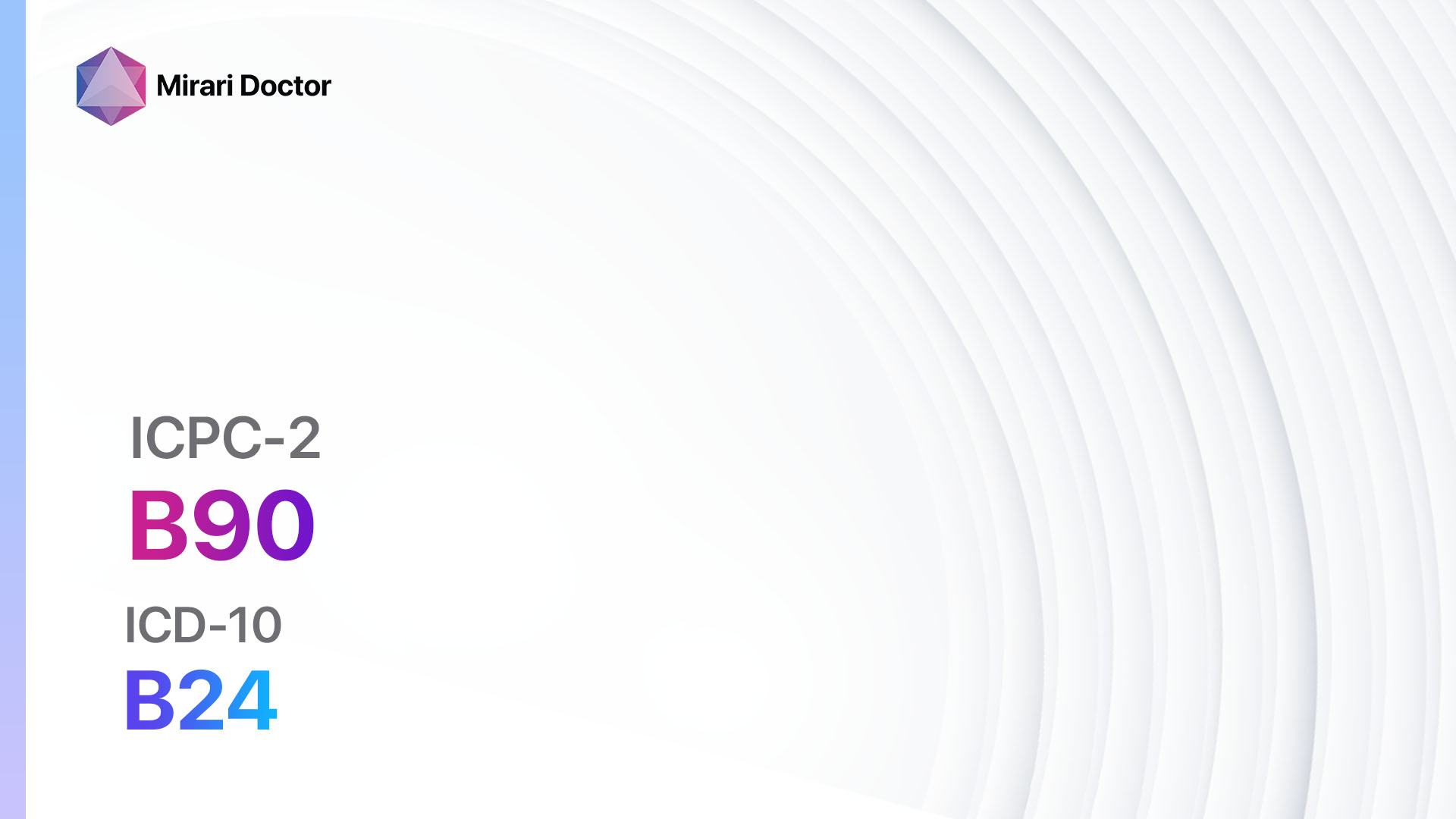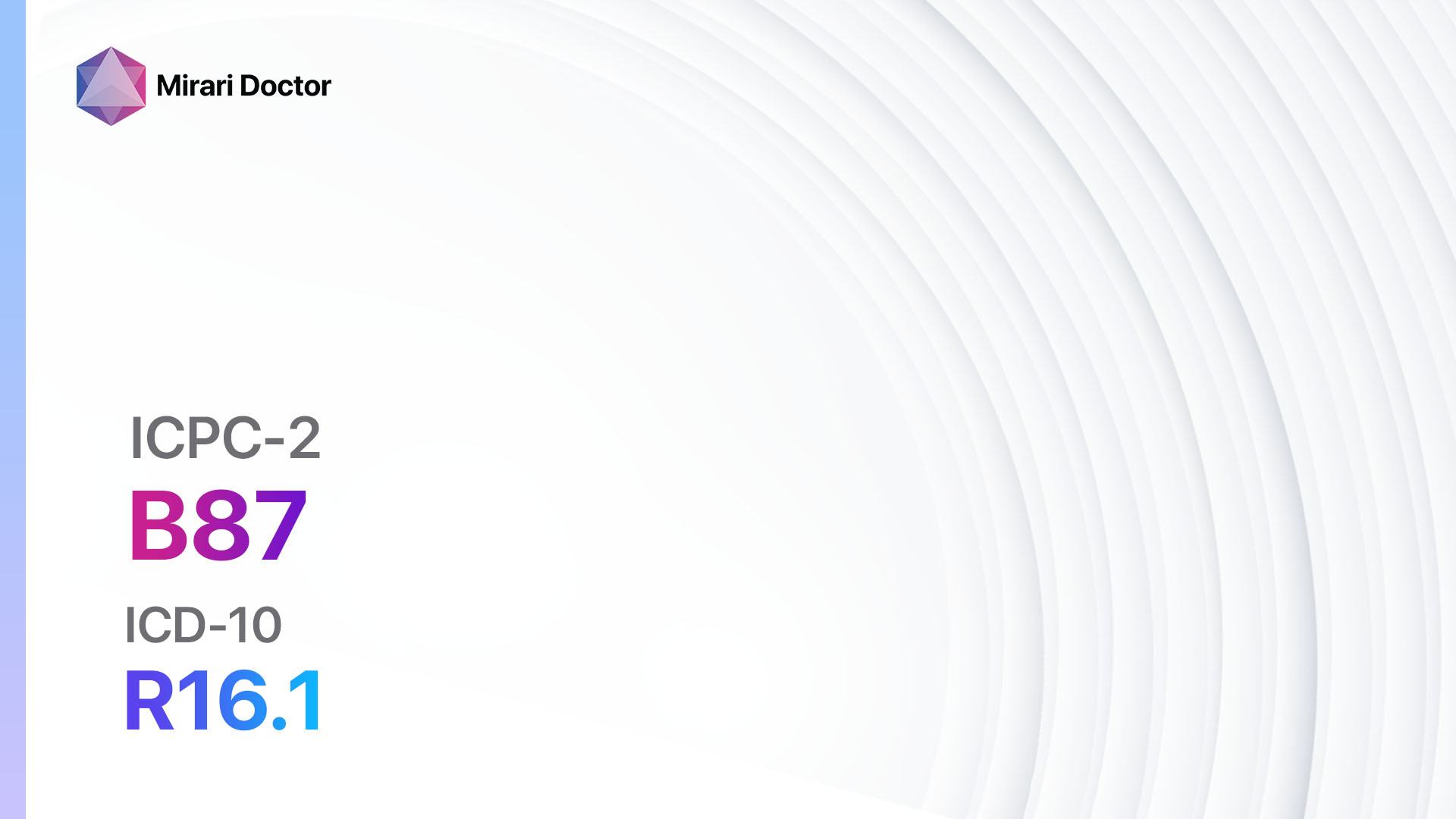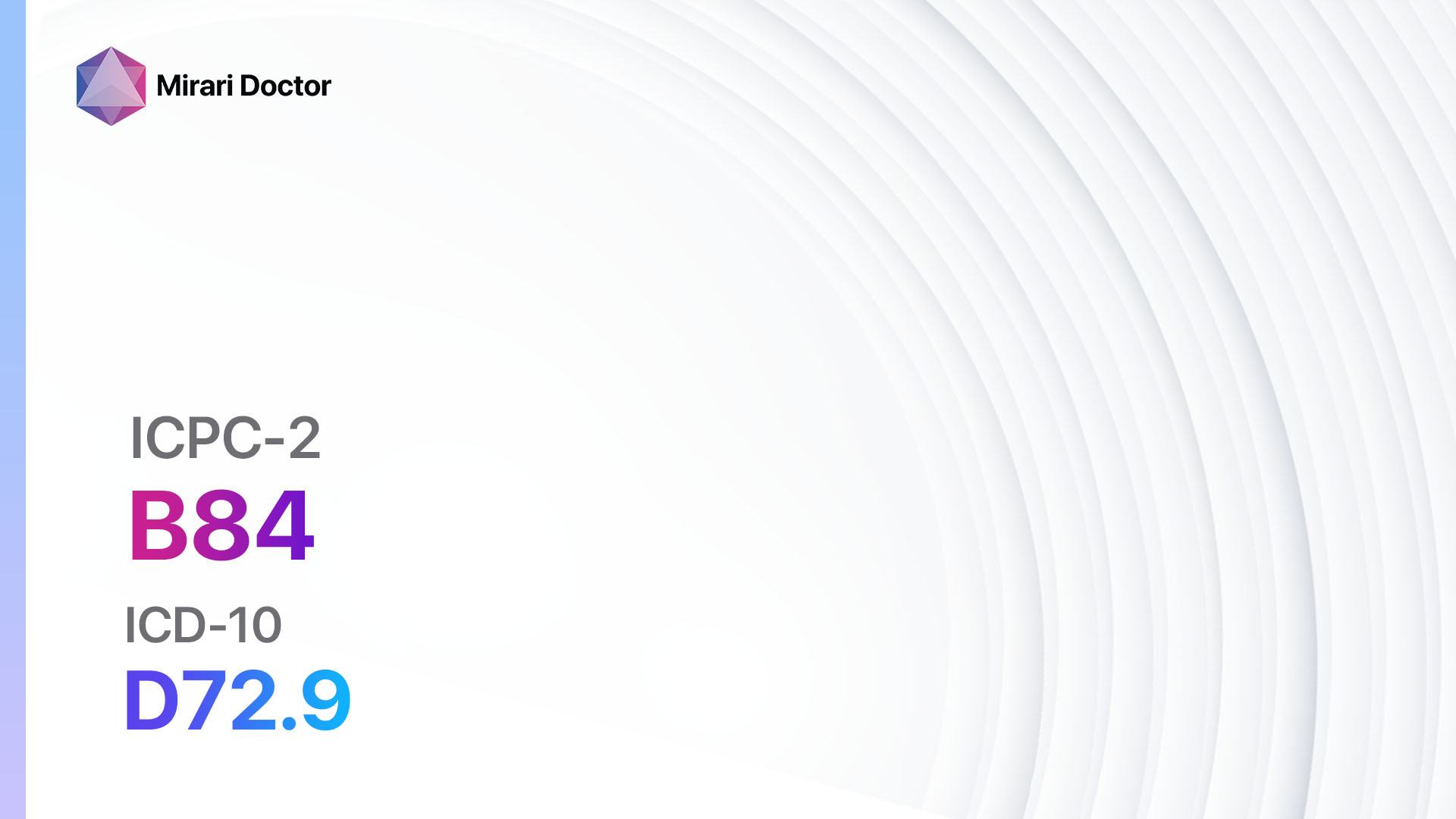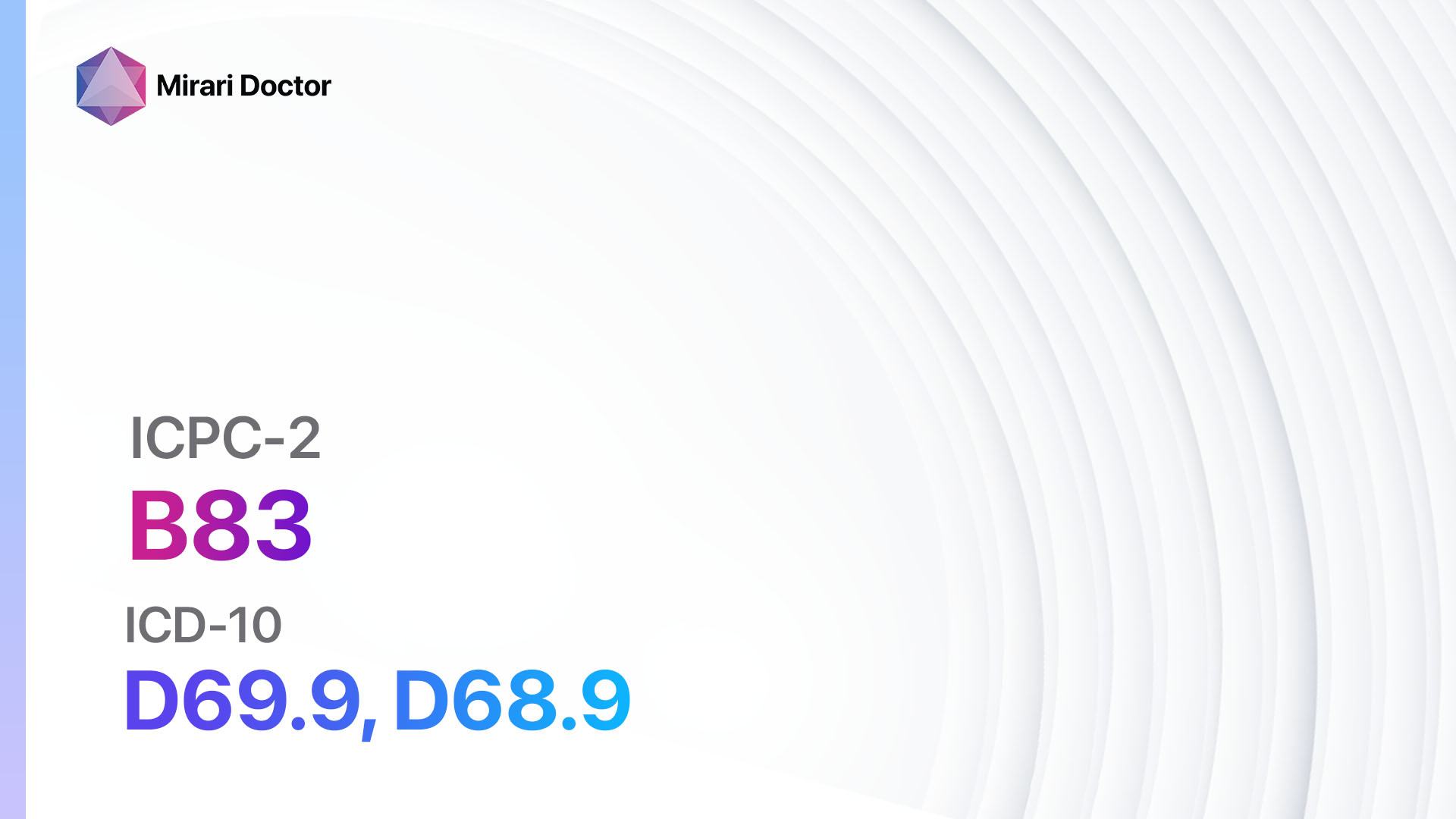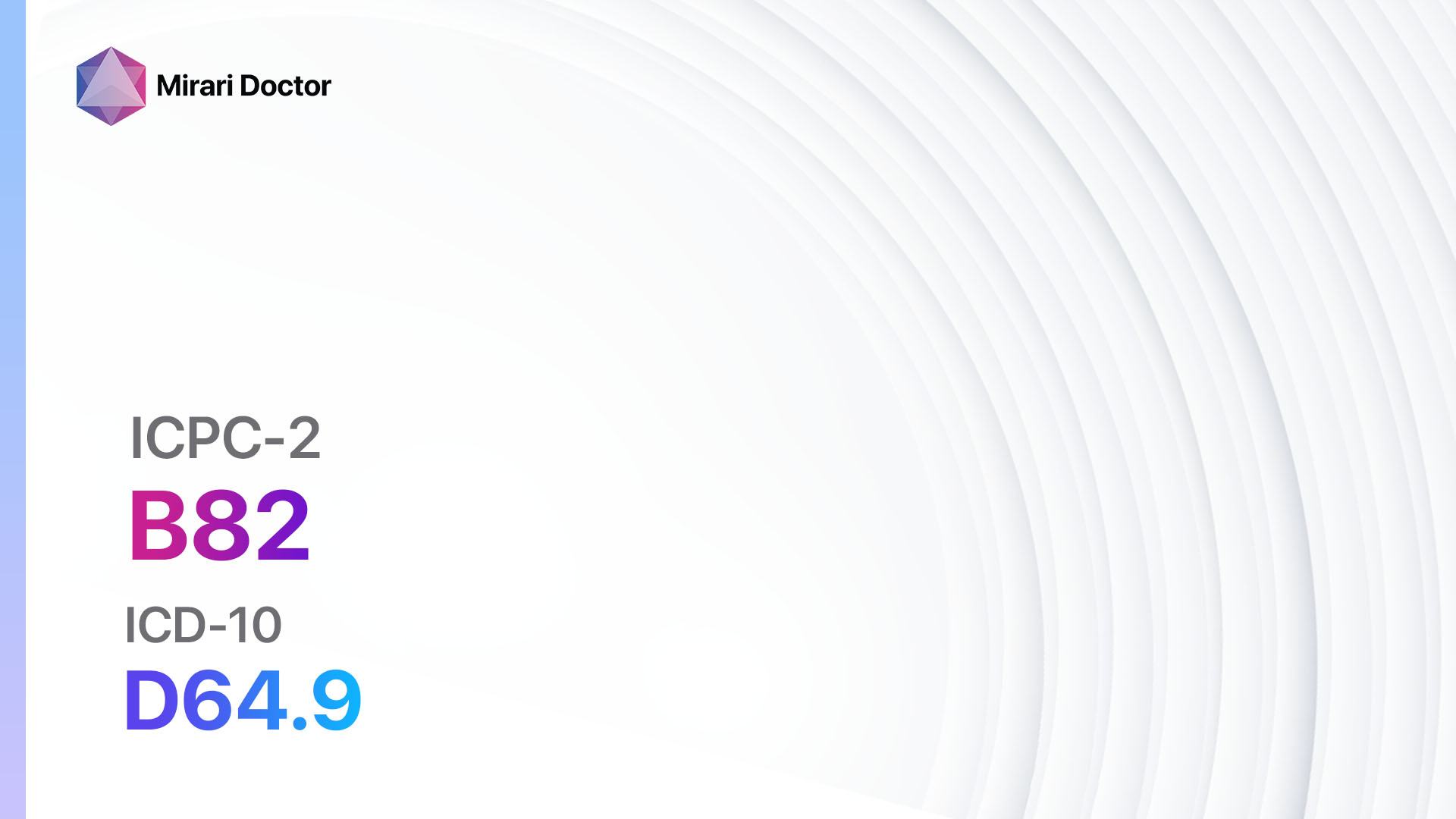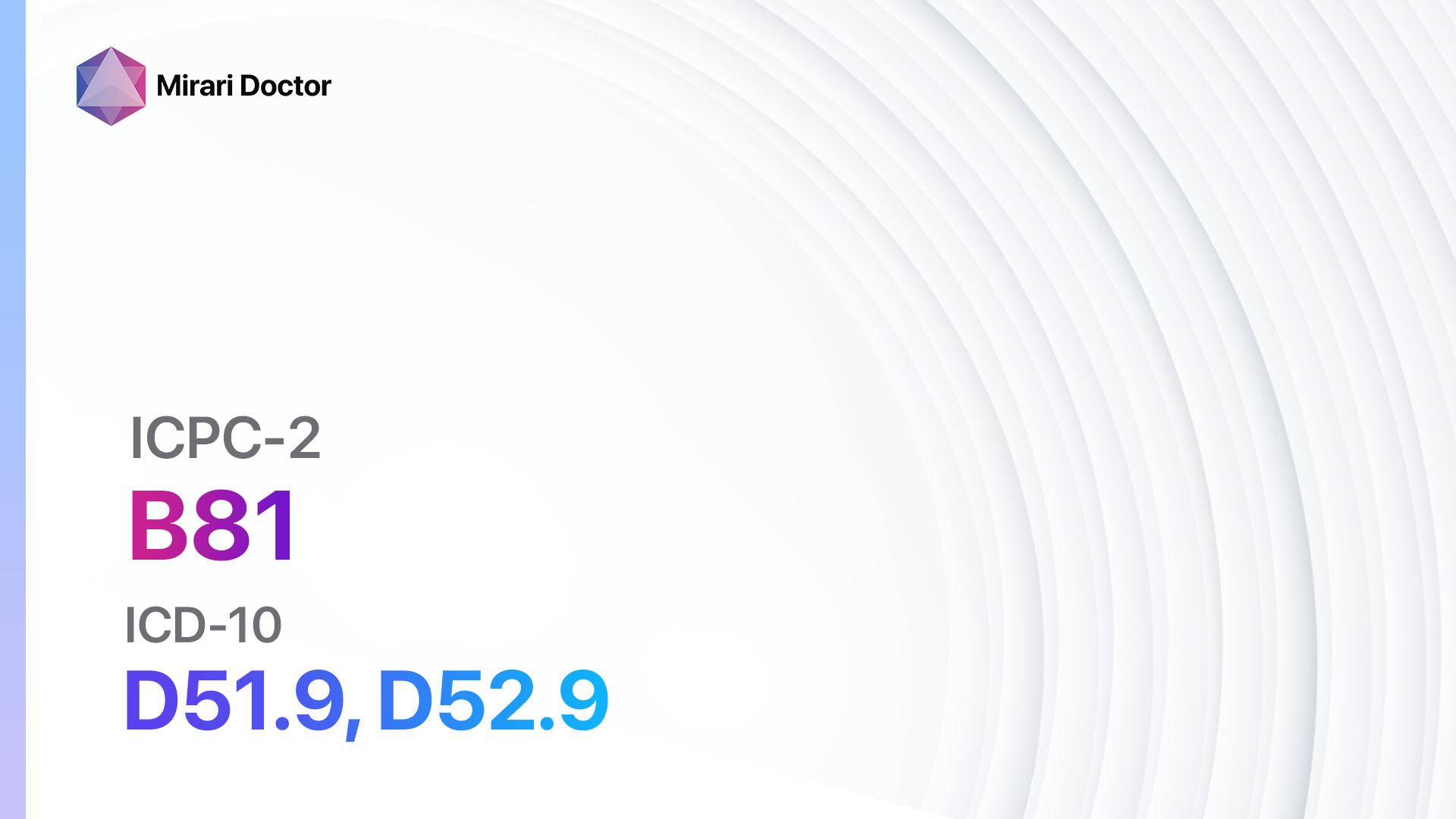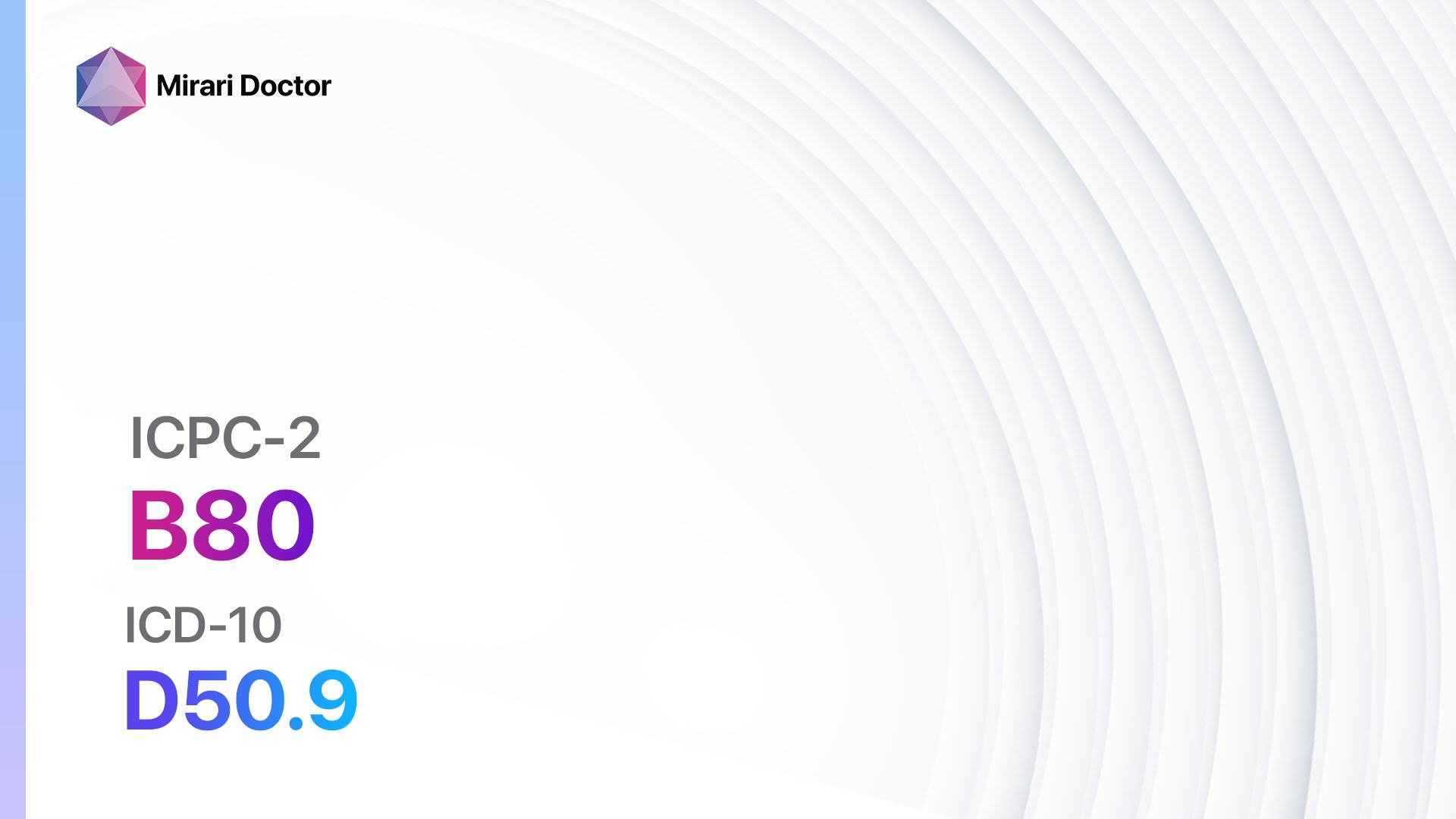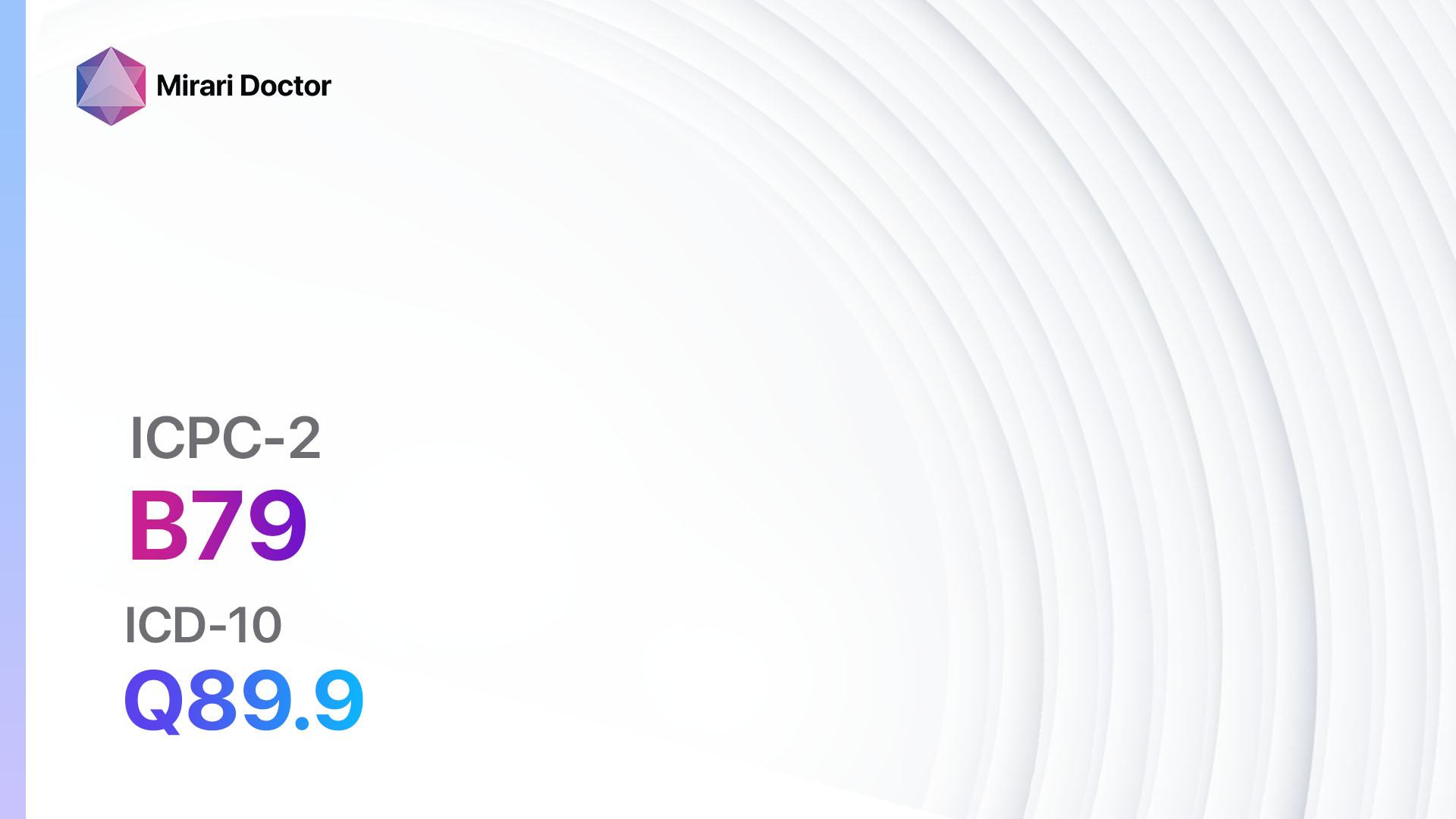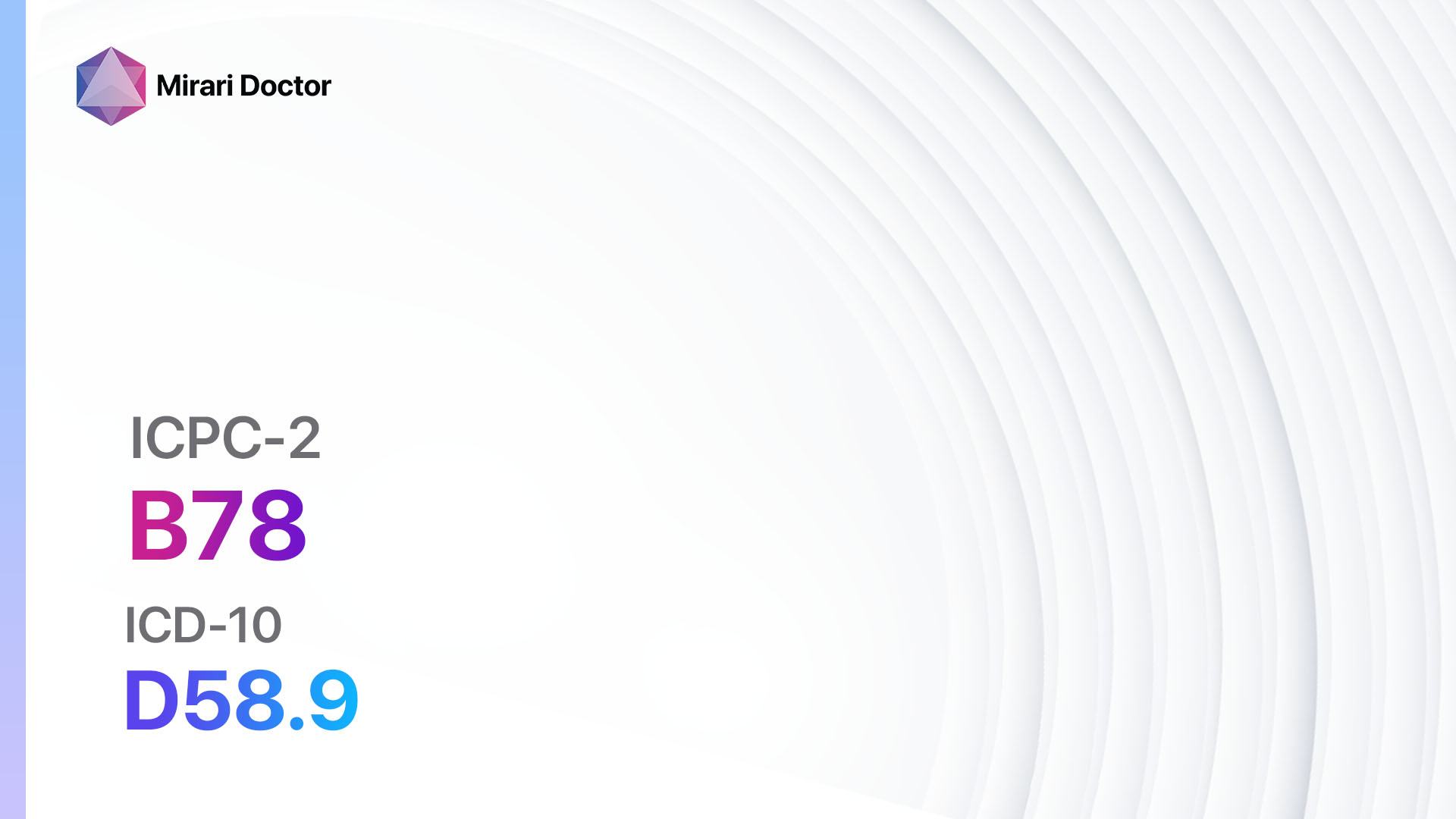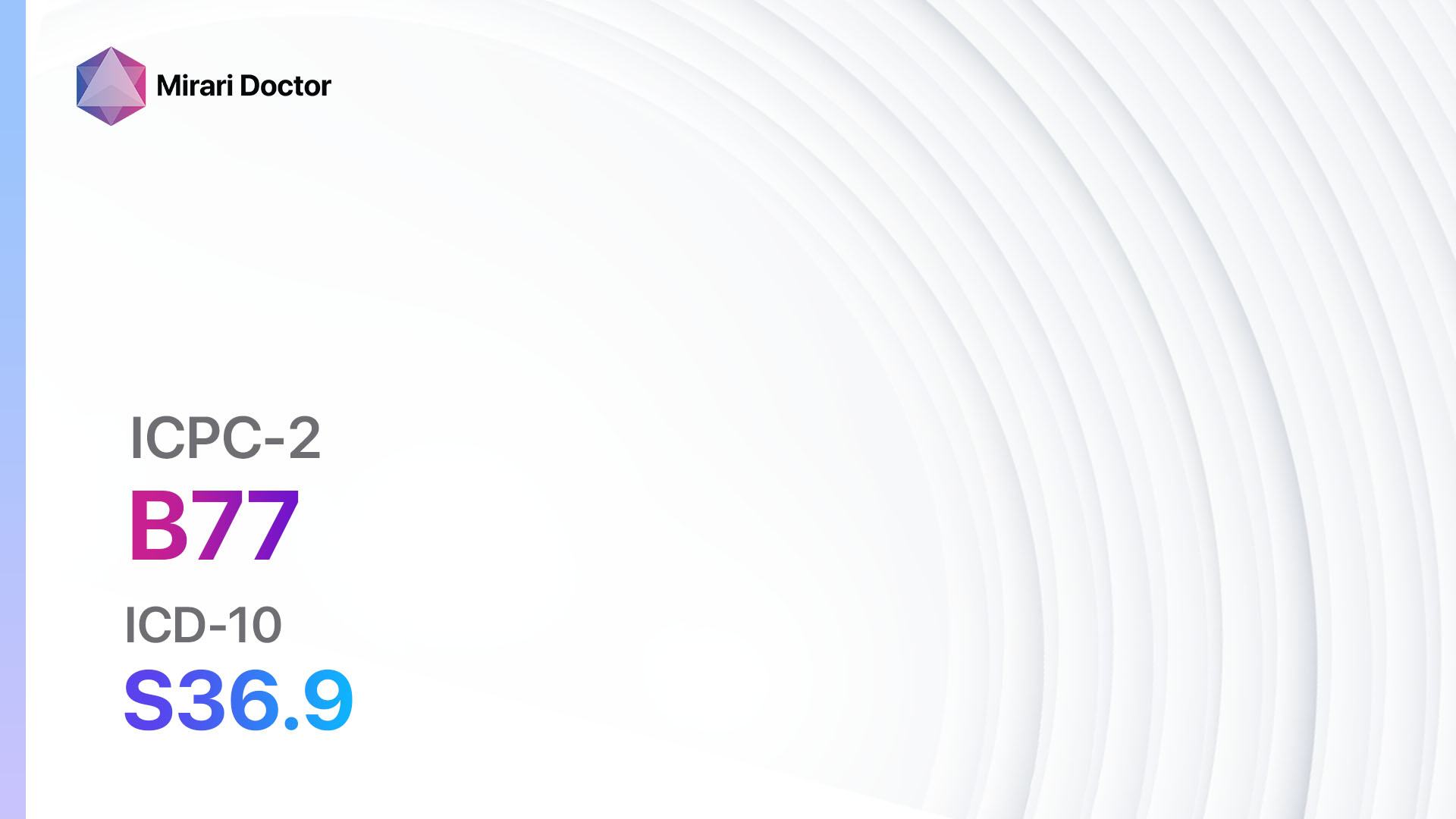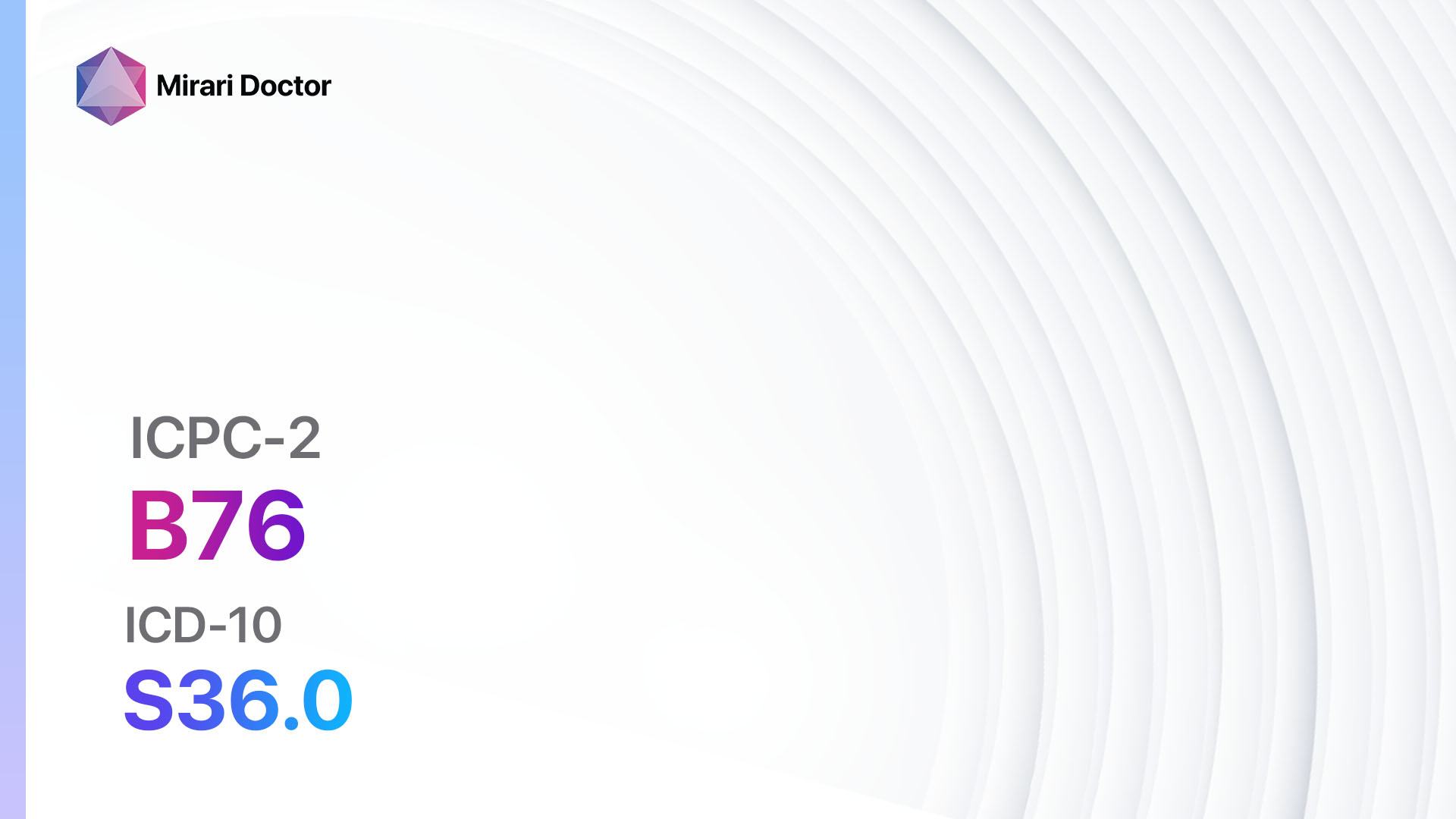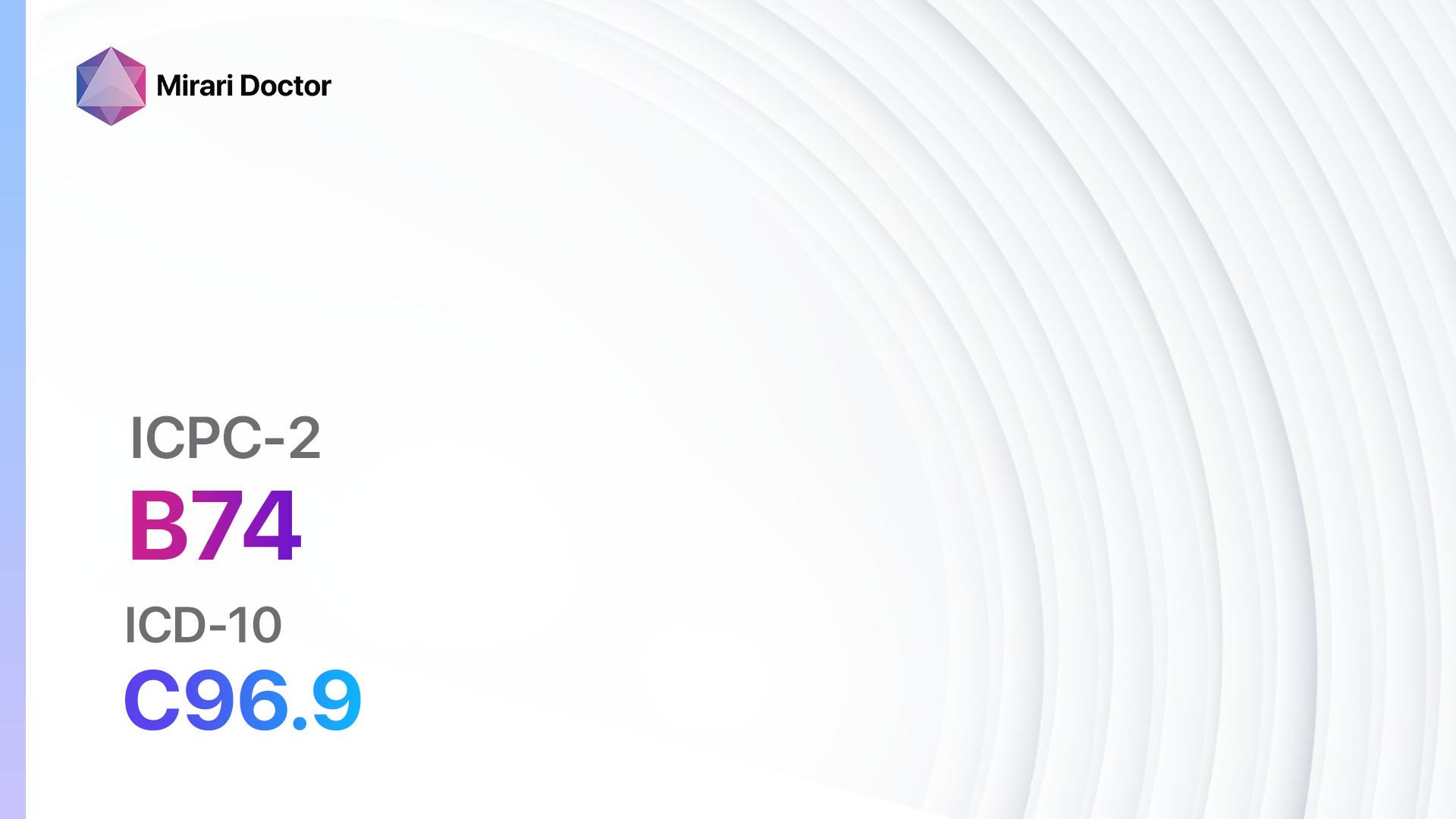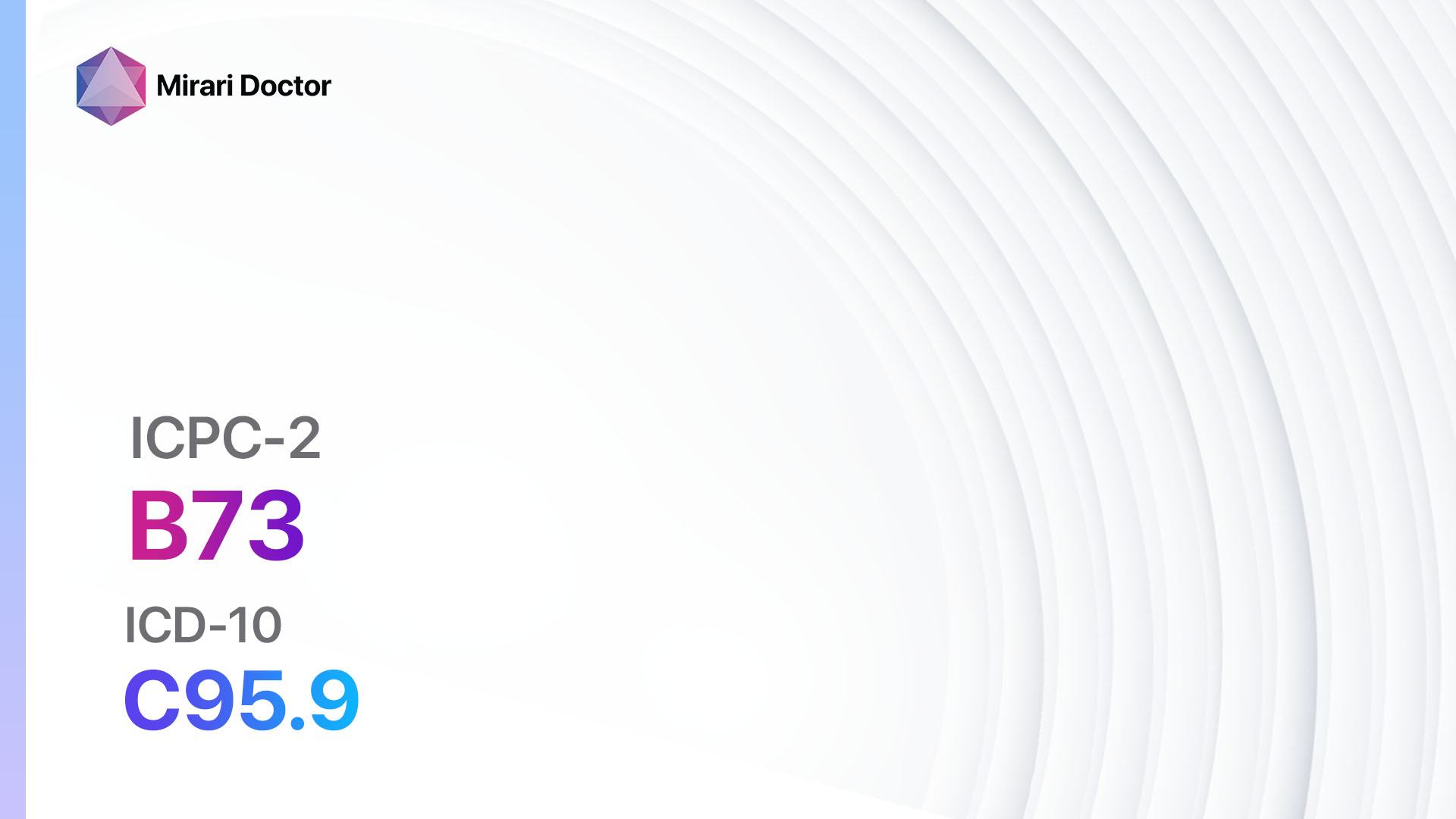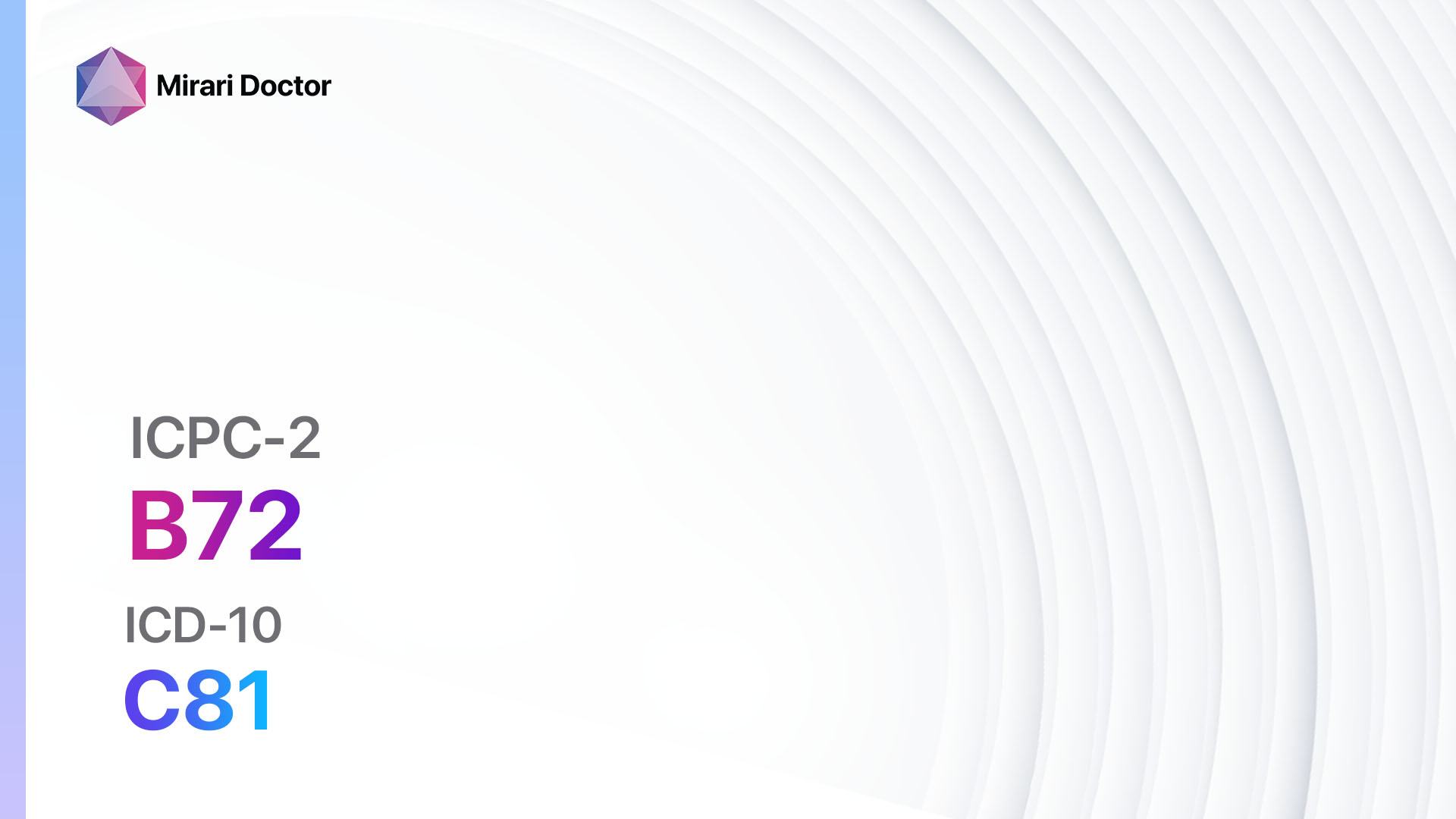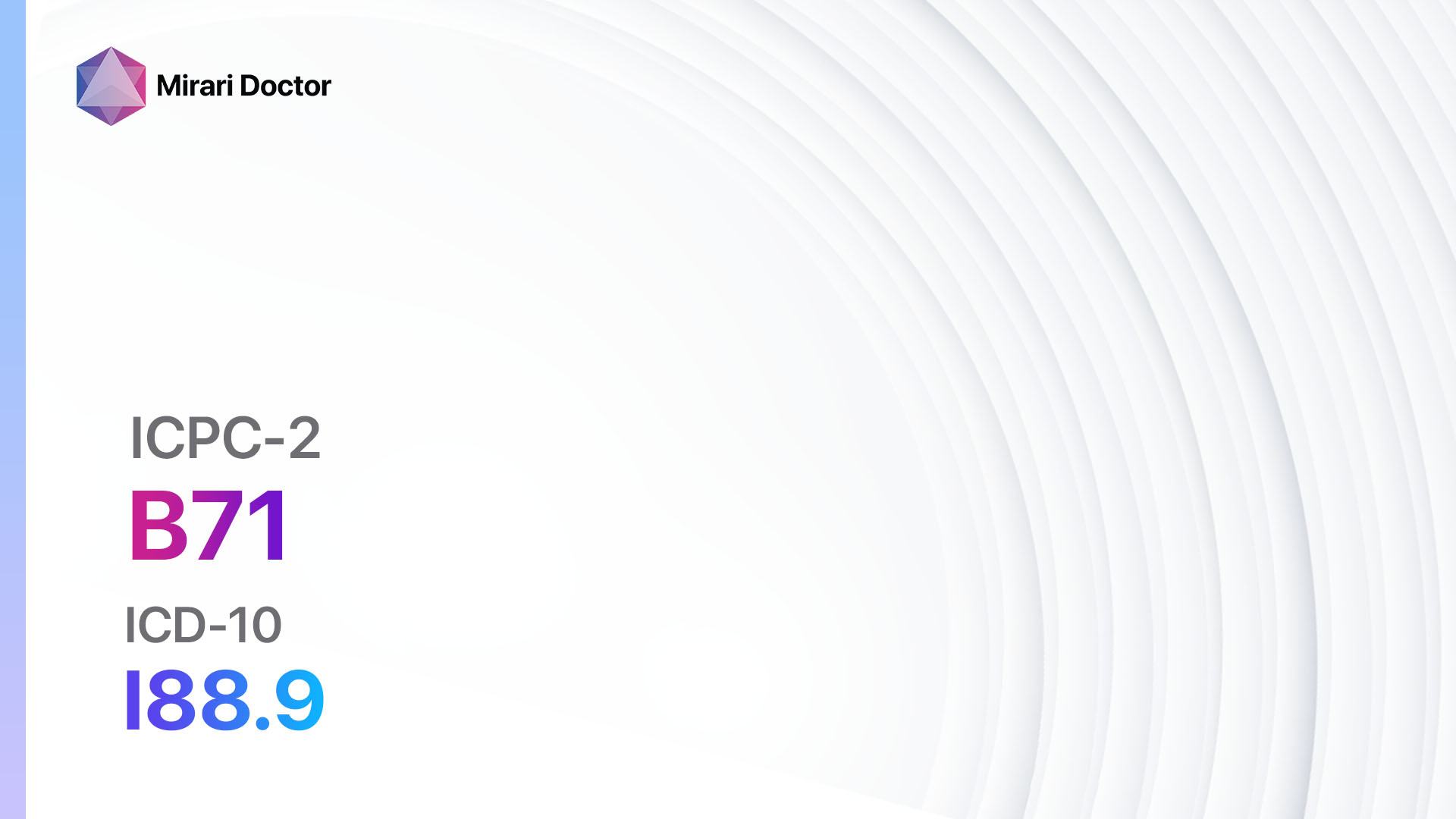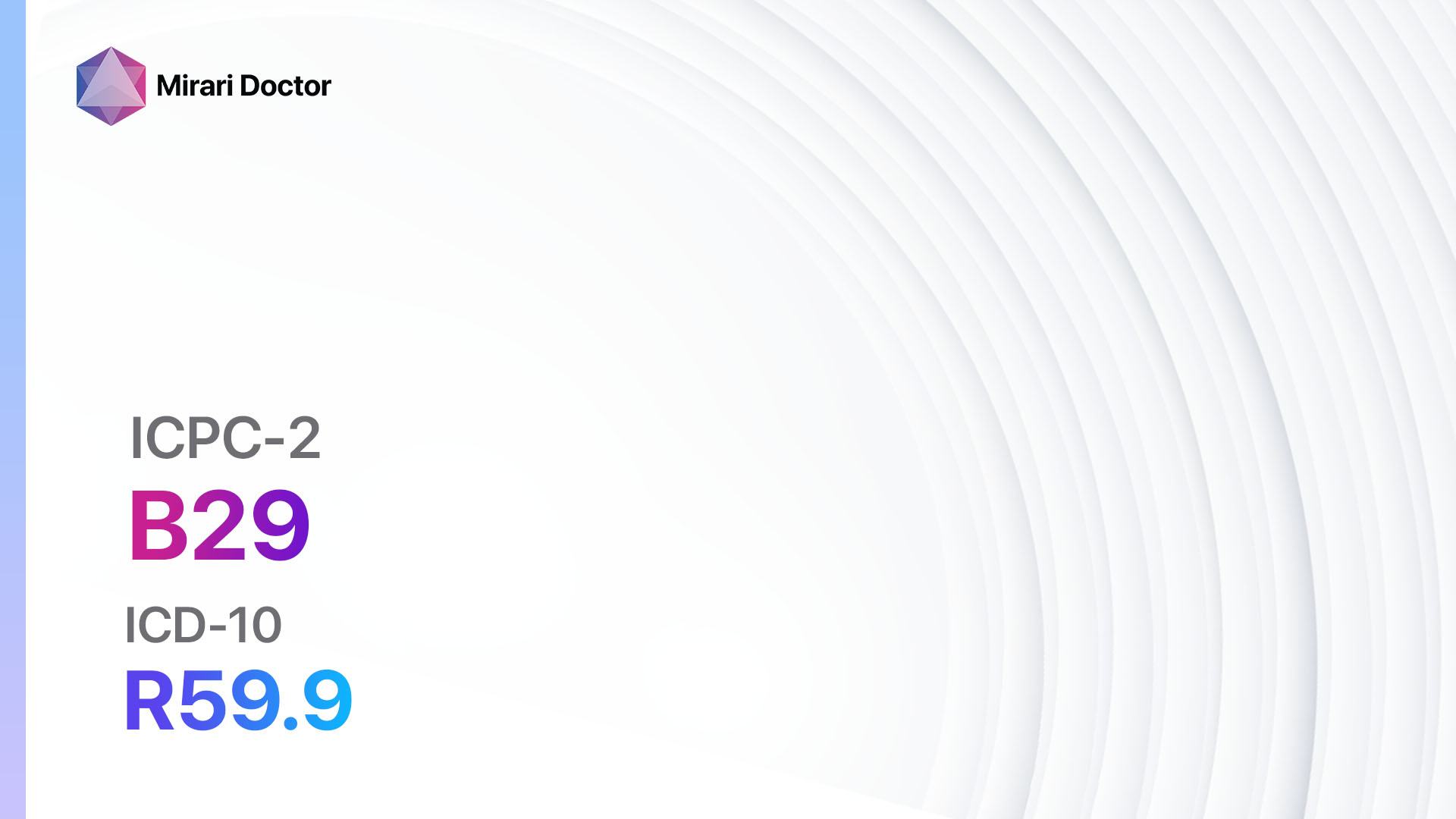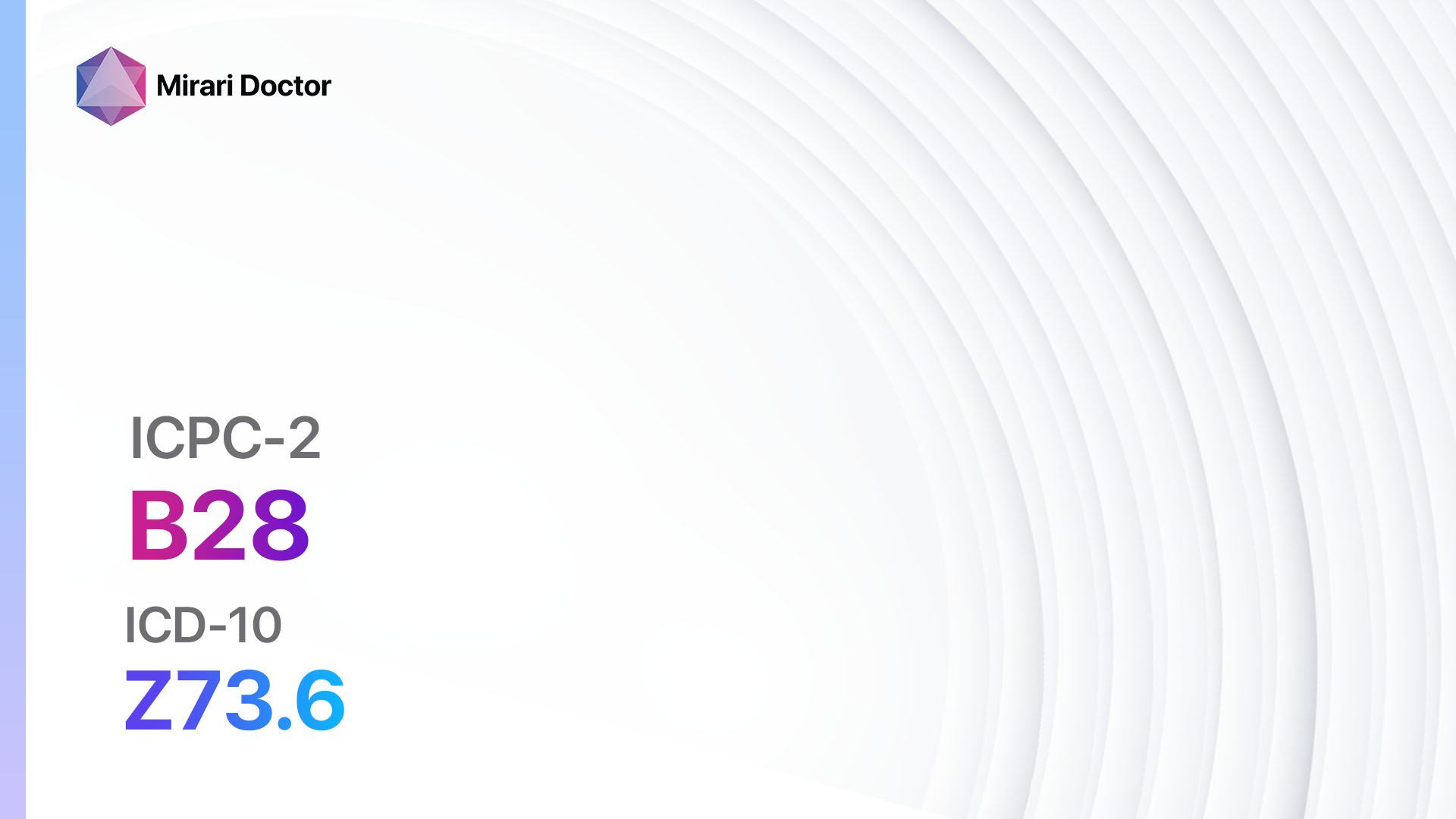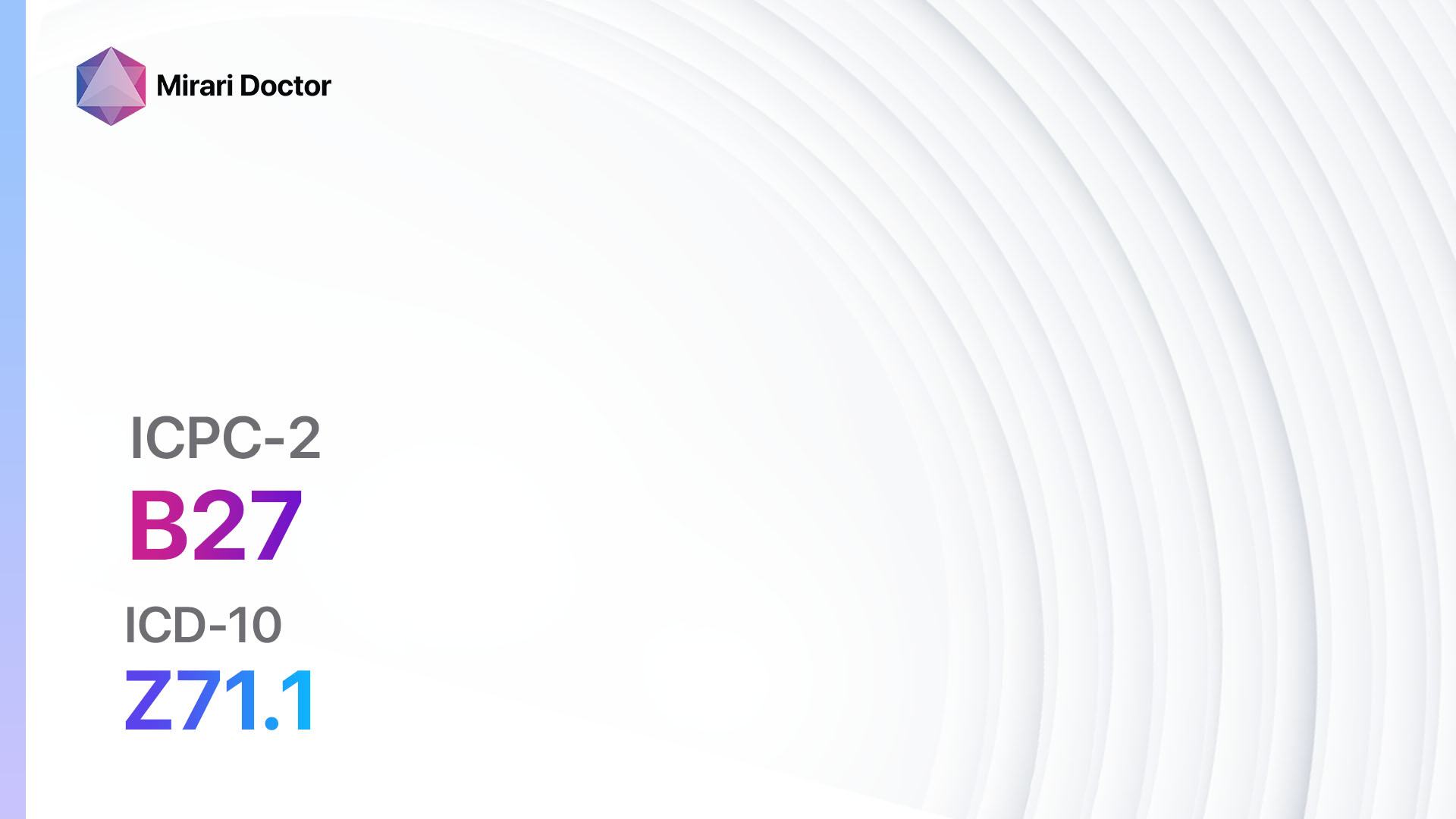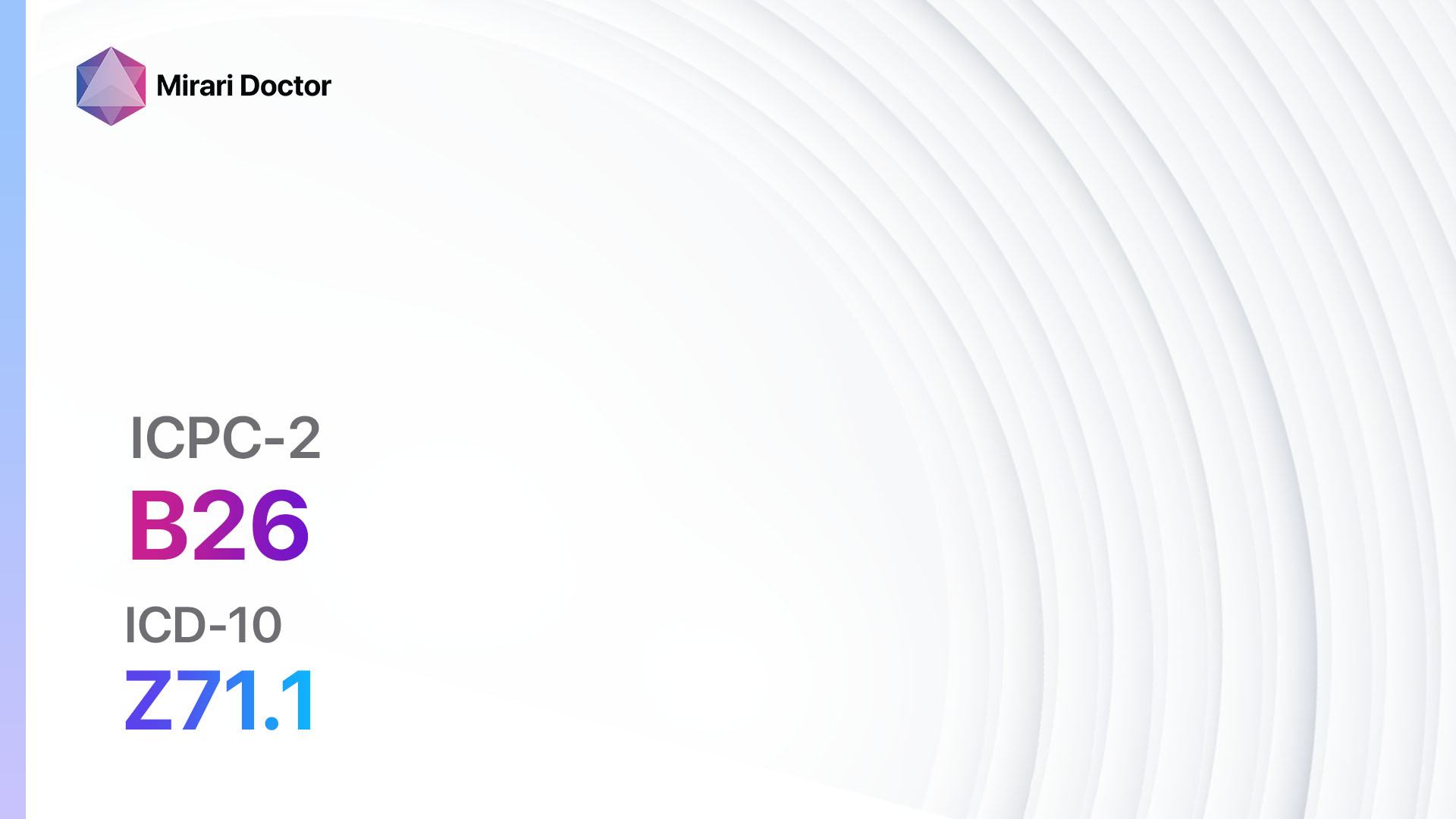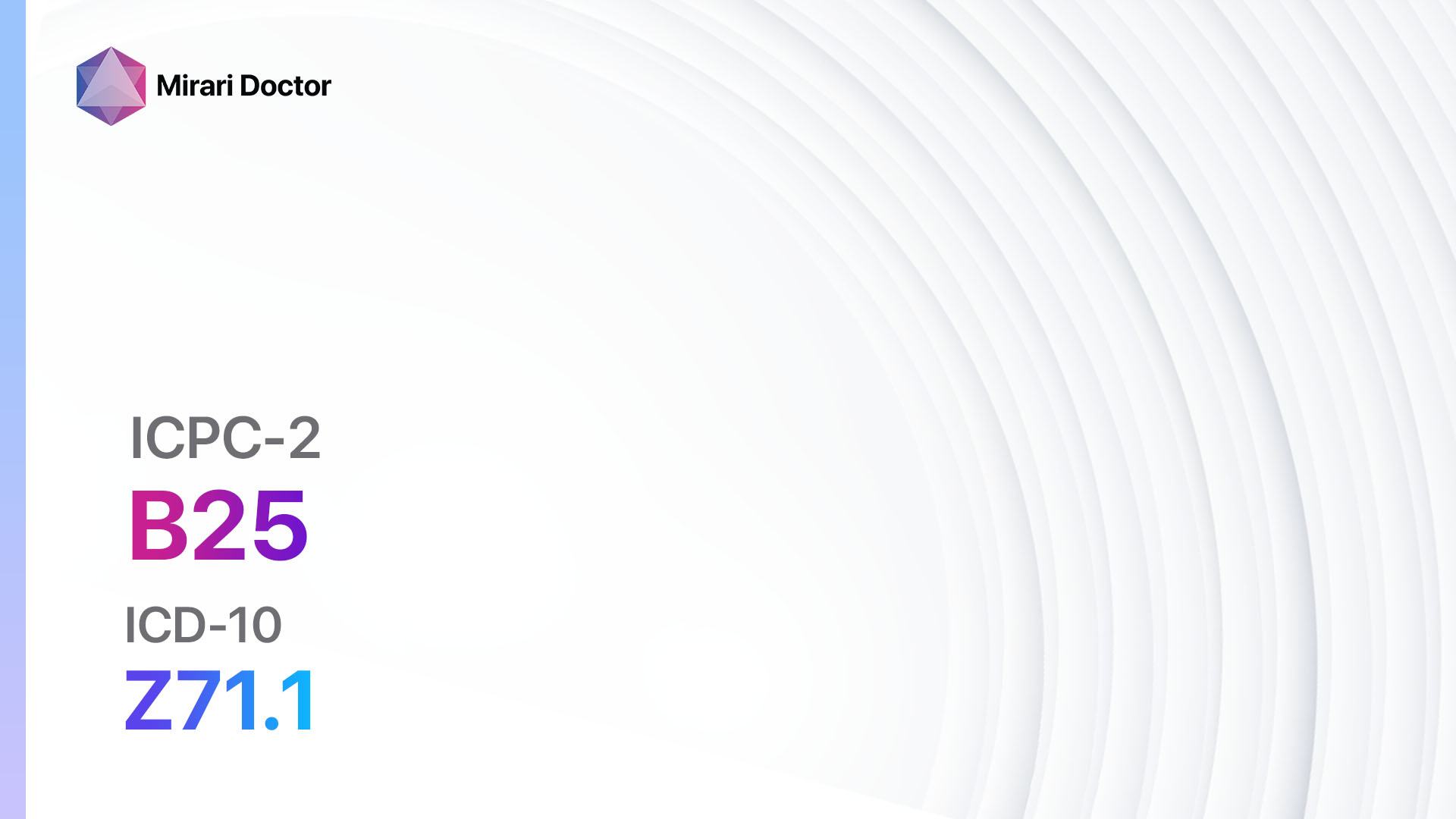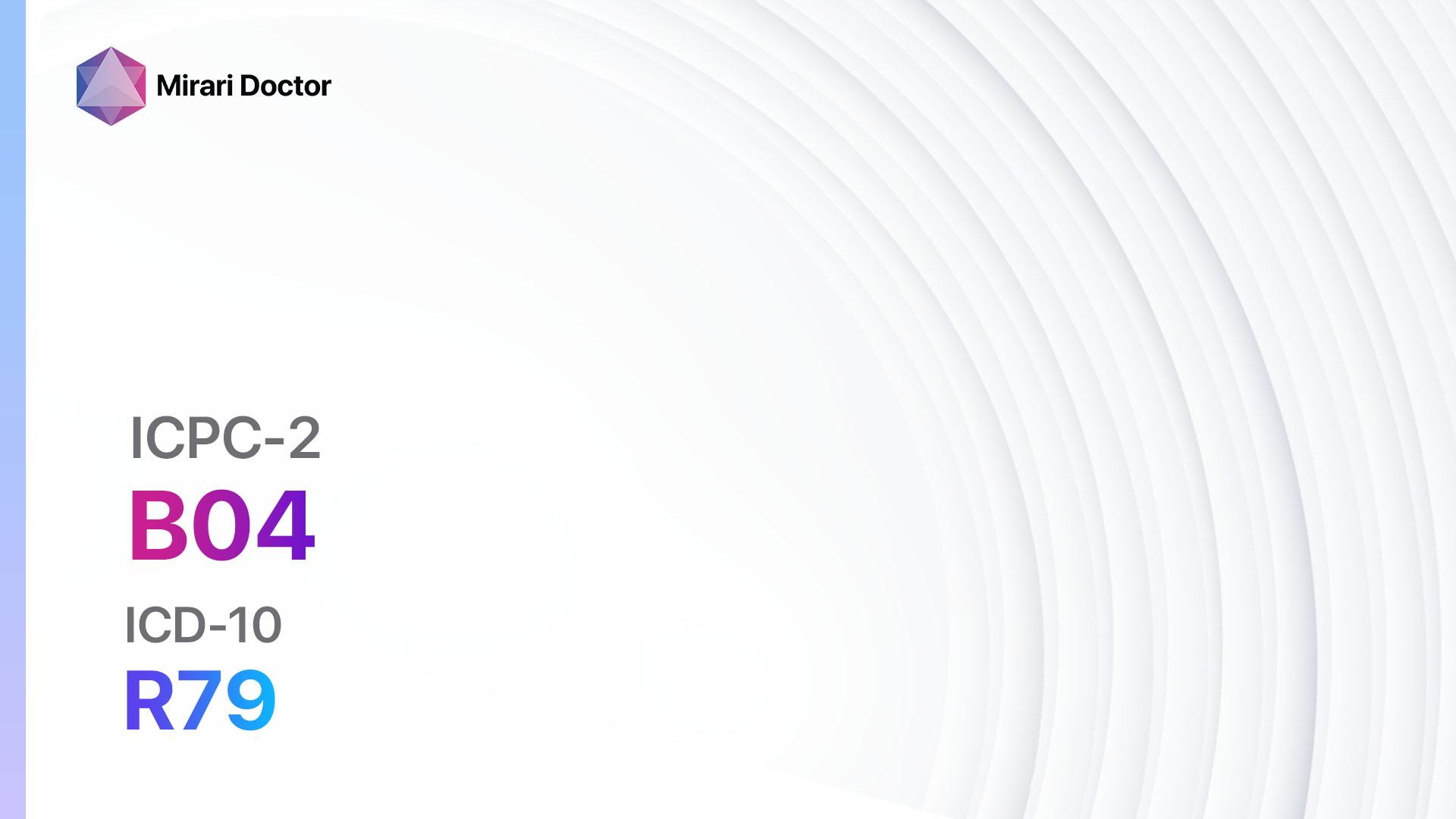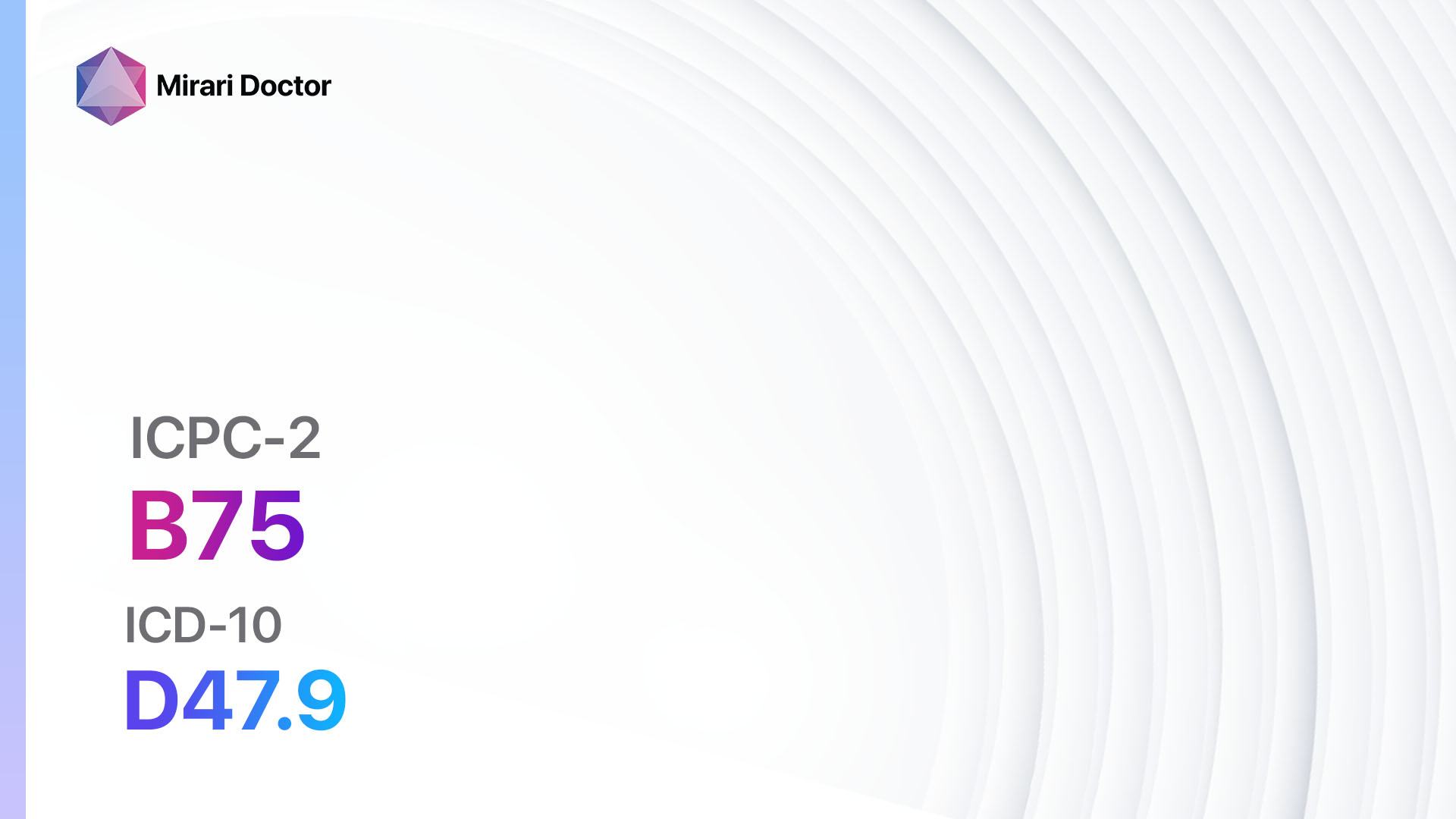
Introduction
Benign/unspecified neoplasm blood refers to the presence of abnormal growths in the blood that are non-cancerous or of unknown nature[1]. While these growths are generally not life-threatening, they can cause symptoms and may require medical intervention[2]. The aim of this guide is to provide an overview of the symptoms, causes, diagnostic steps, possible interventions, and lifestyle interventions for benign/unspecified neoplasm blood.
Codes
- ICPC-2 Code: B75 Benign/unspecified neoplasm blood[3]
- ICD-10 Code: D47.9 Neoplasm of uncertain or unknown behaviour of lymphoid, haematopoietic and related tissue, unspecified[4]
Symptoms
- Fatigue: Patients may experience excessive tiredness and lack of energy[5].
- Easy bruising or bleeding: Abnormal growths in the blood can affect the clotting process, leading to easy bruising or bleeding[6].
- Enlarged lymph nodes: Some patients may notice swollen lymph nodes, particularly in the neck, armpits, or groin[7].
- Frequent infections: Benign/unspecified neoplasm blood can weaken the immune system, making individuals more susceptible to infections[8].
- Unexplained weight loss: In some cases, patients may experience unintentional weight loss[9].
Causes
- Genetic factors: Certain genetic mutations may increase the risk of developing benign/unspecified neoplasm blood[10].
- Environmental factors: Exposure to certain chemicals or toxins may contribute to the development of abnormal growths in the blood.
Diagnostic Steps
Medical History
- Gather information about the patient’s symptoms, including fatigue, easy bruising or bleeding, enlarged lymph nodes, frequent infections, and unexplained weight loss.
- Inquire about any family history of blood disorders or cancers.
- Assess the patient’s medical history, including any previous diagnoses or treatments.
Physical Examination
- Perform a thorough physical examination, paying attention to any signs of enlarged lymph nodes, bruising, or other abnormalities.
- Check for any other symptoms or physical findings that may be indicative of benign/unspecified neoplasm blood.
Laboratory Tests
- Complete blood count (CBC): This test measures the levels of different blood cells, including red blood cells, white blood cells, and platelets.
- Blood chemistry tests: These tests assess the function of various organs, such as the liver and kidneys, which may be affected by benign/unspecified neoplasm blood.
- Coagulation studies: These tests evaluate the blood’s ability to clot properly.
- Bone marrow biopsy: In some cases, a sample of bone marrow may be taken to examine the cells for abnormalities.
Diagnostic Imaging
- X-rays: These imaging studies can help visualize the bones and detect any abnormalities.
- Ultrasound: This non-invasive imaging technique uses sound waves to create images of the internal organs and blood vessels.
- CT scans: These cross-sectional imaging studies provide detailed images of the body’s structures.
- MRI: Magnetic resonance imaging uses powerful magnets and radio waves to generate detailed images of the body’s tissues.
Other Tests
- Flow cytometry: This specialized test analyzes the characteristics of cells in the blood or bone marrow to identify specific types of cells.
- Genetic testing: In some cases, genetic testing may be performed to identify specific genetic mutations associated with benign/unspecified neoplasm blood.
Follow-up and Patient Education
- Schedule regular follow-up appointments to monitor the patient’s condition and response to treatment.
- Provide education to the patient about the nature of benign/unspecified neoplasm blood, potential complications, and the importance of regular monitoring.
Possible Interventions
Traditional Interventions
Medications:
Top 5 drugs for Benign/unspecified neoplasm blood:
- Aspirin:
- Cost: Generic versions can be as low as $3/month.
- Contraindications: Hypersensitivity to aspirin, active bleeding.
- Side effects: Upset stomach, bleeding.
- Severe side effects: Severe bleeding, allergic reactions.
- Drug interactions: NSAIDs, anticoagulants.
- Warning: Risk of bleeding.
- Hydroxyurea:
- Cost: $10-$50/month.
- Contraindications: Severe bone marrow suppression, pregnancy.
- Side effects: Nausea, vomiting, hair loss.
- Severe side effects: Bone marrow suppression, increased risk of infection.
- Drug interactions: None reported.
- Warning: Regular blood tests required.
- Interferon-alpha:
- Cost: $500-$2,000/month.
- Contraindications: Severe depression, autoimmune disorders.
- Side effects: Flu-like symptoms, fatigue, depression.
- Severe side effects: Severe depression, suicidal thoughts.
- Drug interactions: None reported.
- Warning: Regular monitoring of mental health required.
- Imatinib:
- Cost: $10,000-$15,000/month.
- Contraindications: Hypersensitivity to imatinib, severe liver impairment.
- Side effects: Nausea, vomiting, muscle cramps.
- Severe side effects: Liver toxicity, heart problems.
- Drug interactions: CYP3A4 inhibitors, CYP3A4 inducers.
- Warning: Regular liver function tests required.
- Rituximab:
- Cost: $5,000-$10,000/month.
- Contraindications: Hypersensitivity to rituximab, severe infections.
- Side effects: Infusion reactions, fatigue, low blood cell counts.
- Severe side effects: Severe infections, heart problems.
- Drug interactions: None reported.
- Warning: Risk of severe infusion reactions.
Alternative Drugs:
- Prednisone: A corticosteroid that can help reduce inflammation and suppress the immune system.
- Cyclophosphamide: A chemotherapy drug that can be used to treat certain types of blood disorders.
- Lenalidomide: An immunomodulatory drug that can be used in the treatment of certain blood disorders.
- Azathioprine: An immunosuppressive drug that can help reduce the activity of the immune system.
- Methotrexate: A chemotherapy drug that can be used to treat certain types of blood disorders.
Surgical Procedures:
- None recommended for the treatment of benign/unspecified neoplasm blood.
Alternative Interventions
- Acupuncture: May help improve overall well-being and reduce symptoms. Cost: $60-$120 per session.
- Herbal supplements: Some herbs, such as turmeric and ginger, may have anti-inflammatory properties. Cost: Varies depending on the specific supplement.
- Mind-body techniques: Practices such as meditation, yoga, and tai chi may help reduce stress and improve overall health. Cost: Varies depending on the specific practice.
- Dietary modifications: A healthy diet rich in fruits, vegetables, and whole grains can support overall health. Cost: Varies depending on individual food choices.
- Exercise: Regular physical activity can improve circulation and overall well-being. Cost: Varies depending on individual preferences and access to exercise facilities.
Lifestyle Interventions
- Stress management: Techniques such as deep breathing, meditation, or mindfulness can help reduce stress and support overall well-being. Cost: Varies depending on the specific practice.
- Sleep hygiene: Getting adequate sleep is essential for overall health and well-being. Cost: Varies depending on individual sleep habits and preferences.
- Healthy diet: A balanced diet rich in fruits, vegetables, whole grains, and lean proteins can support overall health. Cost: Varies depending on individual food choices.
- Regular exercise: Engaging in regular physical activity can improve circulation and overall well-being. Cost: Varies depending on individual preferences and access to exercise facilities.
- Smoking cessation: Quitting smoking can improve overall health and reduce the risk of complications. Cost: Varies depending on individual smoking cessation methods.
It is important to note that the cost ranges provided are approximate and may vary depending on the location and availability of the interventions. It is recommended to consult with a healthcare professional for personalized treatment recommendations and cost estimates.
Mirari Cold Plasma Alternative Intervention
Understanding Mirari Cold Plasma
- Safe and Non-Invasive Treatment: Mirari Cold Plasma is a safe and non-invasive treatment option for various skin conditions. It does not require incisions, minimizing the risk of scarring, bleeding, or tissue damage.
- Efficient Extraction of Foreign Bodies: Mirari Cold Plasma facilitates the removal of foreign bodies from the skin by degrading and dissociating organic matter, allowing easier access and extraction.
- Pain Reduction and Comfort: Mirari Cold Plasma has a local analgesic effect, providing pain relief during the treatment, making it more comfortable for the patient.
- Reduced Risk of Infection: Mirari Cold Plasma has antimicrobial properties, effectively killing bacteria and reducing the risk of infection.
- Accelerated Healing and Minimal Scarring: Mirari Cold Plasma stimulates wound healing and tissue regeneration, reducing healing time and minimizing the formation of scars.
Mirari Cold Plasma Prescription
Video instructions for using Mirari Cold Plasma Device – B75 Benign/unspecified neoplasm blood (ICD-10:D47.9)
| Mild | Moderate | Severe |
| Mode setting: 1 (Infection) Location: 1 (Sacrum) Morning: 15 minutes, Evening: 15 minutes |
Mode setting: 1 (Infection) Location: 1 (Sacrum) Morning: 30 minutes, Lunch: 30 minutes, Evening: 30 minutes |
Mode setting: 1 (Infection) Location: 1 (Sacrum) Morning: 30 minutes, Lunch: 30 minutes, Evening: 30 minutes |
| Mode setting: 2 (Wound Healing) Location: 1 (Sacrum) Morning: 15 minutes, Evening: 15 minutes |
Mode setting: 2 (Wound Healing) Location: 1 (Sacrum) Morning: 30 minutes, Lunch: 30 minutes, Evening: 30 minutes |
Mode setting: 2 (Wound Healing) Location: 1 (Sacrum) Morning: 30 minutes, Lunch: 30 minutes, Evening: 30 minutes |
| Mode setting: 3 (Antiviral Therapy) Location: 1 (Sacrum) Morning: 15 minutes, Evening: 15 minutes |
Mode setting: 3 (Antiviral Therapy) Location: 1 (Sacrum) Morning: 30 minutes, Lunch: 30 minutes, Evening: 30 minutes |
Mode setting: 3 (Antiviral Therapy) Location: 1 (Sacrum) Morning: 30 minutes, Lunch: 30 minutes, Evening: 30 minutes |
| Mode setting: 7 (Immunotherapy) Location: 1 (Sacrum) Morning: 15 minutes, Evening: 15 minutes |
Mode setting: 7 (Immunotherapy) Location: 1 (Sacrum) Morning: 30 minutes, Lunch: 30 minutes, Evening: 30 minutes |
Mode setting: 7 (Immunotherapy) Location: 1 (Sacrum) Morning: 30 minutes, Lunch: 30 minutes, Evening: 30 minutes |
| Total Morning: 60 minutes approx. $10 USD, Evening: 60 minutes approx. $10 USD |
Total Morning: 120 minutes approx. $20 USD, Lunch: 120 minutes approx. $20 USD, Evening: 120 minutes approx. $20 USD, |
Total Morning: 120 minutes approx. $20 USD, Lunch: 120 minutes approx. $20 USD, Evening: 120 minutes approx. $20 USD, |
| Usual treatment for 7-60 days approx. $140 USD – $1200 USD | Usual treatment for 6-8 weeks approx. $2,520 USD – $3,360 USD |
Usual treatment for 3-6 months approx. $5,400 USD – $10,800 USD
|
 |
|
Use the Mirari Cold Plasma device to treat Benign/unspecified neoplasm blood effectively.
WARNING: MIRARI COLD PLASMA IS DESIGNED FOR THE HUMAN BODY WITHOUT ANY ARTIFICIAL OR THIRD PARTY PRODUCTS. USE OF OTHER PRODUCTS IN COMBINATION WITH MIRARI COLD PLASMA MAY CAUSE UNPREDICTABLE EFFECTS, HARM OR INJURY. PLEASE CONSULT A MEDICAL PROFESSIONAL BEFORE COMBINING ANY OTHER PRODUCTS WITH USE OF MIRARI.
Step 1: Cleanse the Skin
- Start by cleaning the affected area of the skin with a gentle cleanser or mild soap and water. Gently pat the area dry with a clean towel.
Step 2: Prepare the Mirari Cold Plasma device
- Ensure that the Mirari Cold Plasma device is fully charged or has fresh batteries as per the manufacturer’s instructions. Make sure the device is clean and in good working condition.
- Switch on the Mirari device using the power button or by following the specific instructions provided with the device.
- Some Mirari devices may have adjustable settings for intensity or treatment duration. Follow the manufacturer’s instructions to select the appropriate settings based on your needs and the recommended guidelines.
Step 3: Apply the Device
- Place the Mirari device in direct contact with the affected area of the skin. Gently glide or hold the device over the skin surface, ensuring even coverage of the area experiencing.
- Slowly move the Mirari device in a circular motion or follow a specific pattern as indicated in the user manual. This helps ensure thorough treatment coverage.
Step 4: Monitor and Assess:
- Keep track of your progress and evaluate the effectiveness of the Mirari device in managing your Benign/unspecified neoplasm blood. If you have any concerns or notice any adverse reactions, consult with your health care professional.
Note
This guide is for informational purposes only and should not replace the advice of a medical professional. Always consult with your healthcare provider or a qualified medical professional for personal advice, diagnosis, or treatment. Do not solely rely on the information presented here for decisions about your health. Use of this information is at your own risk. The authors of this guide, nor any associated entities or platforms, are not responsible for any potential adverse effects or outcomes based on the content.
Mirari Cold Plasma System Disclaimer
- Purpose: The Mirari Cold Plasma System is a Class 2 medical device designed for use by trained healthcare professionals. It is registered for use in Thailand and Vietnam. It is not intended for use outside of these locations.
- Informational Use: The content and information provided with the device are for educational and informational purposes only. They are not a substitute for professional medical advice or care.
- Variable Outcomes: While the device is approved for specific uses, individual outcomes can differ. We do not assert or guarantee specific medical outcomes.
- Consultation: Prior to utilizing the device or making decisions based on its content, it is essential to consult with a Certified Mirari Tele-Therapist and your medical healthcare provider regarding specific protocols.
- Liability: By using this device, users are acknowledging and accepting all potential risks. Neither the manufacturer nor the distributor will be held accountable for any adverse reactions, injuries, or damages stemming from its use.
- Geographical Availability: This device has received approval for designated purposes by the Thai and Vietnam FDA. As of now, outside of Thailand and Vietnam, the Mirari Cold Plasma System is not available for purchase or use.
References
- Neoplasms. (2021). National Cancer Institute. https://www.cancer.gov/publications/dictionaries/cancer-terms/def/neoplasm
- Benign Tumors. (2021). National Cancer Institute. https://www.cancer.gov/about-cancer/diagnosis-staging/benign-tumors
- ICPC-2 – English. (n.d.). World Health Organization. https://www.who.int/standards/classifications/other-classifications/international-classification-of-primary-care
- 2022 ICD-10-CM Diagnosis Code D47.9. (2022). ICD10Data.com. https://www.icd10data.com/ICD10CM/Codes/C00-D49/D37-D48/D47-/D47.9
- Neoplasms of Uncertain Behavior. (2021). MSD Manual Professional Version. https://www.msdmanuals.com/professional/hematology-and-oncology/neoplasms-of-uncertain-behavior/overview-of-neoplasms-of-uncertain-behavior
- Bleeding Disorders. (2021). MedlinePlus. https://medlineplus.gov/bleedingdisorders.html
- Swollen Lymph Nodes. (2020). Mayo Clinic. https://www.mayoclinic.org/diseases-conditions/swollen-lymph-nodes/symptoms-causes/syc-20353902
- Neoplasms of Uncertain Behavior. (2021). MSD Manual Professional Version. https://www.msdmanuals.com/professional/hematology-and-oncology/neoplasms-of-uncertain-behavior/overview-of-neoplasms-of-uncertain-behavior
- Unexplained Weight Loss. (2021). Mayo Clinic. https://www.mayoclinic.org/symptoms/unexplained-weight-loss/basics/definition/sym-20050700
- Myeloproliferative Neoplasms. (2021). National Cancer Institute. https://www.cancer.gov/types/myeloproliferative
Related articles
Made in USA


